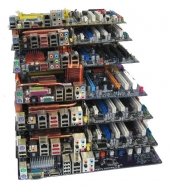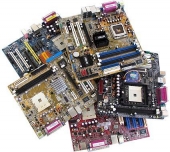The motherboard is like the central nervous system of the computer – it links everything together and facilitates the communication between all the rest of the components. While motherboard choice is important, most of the decision has already been made by the time you select the rest of your components. Your motherboard has to be compatible with everything else you’ve selected, and the average user has little left to choose from once you’re at this point. The processor socket has to match the processor you’ve chosen, and that’s the first thing to look for in your motherboard: Is it compatible with your hardware? The motherboard will have to support your processor and RAM choices, and after that you’re looking at performance and features.
Performance-wise, the interfaces on the motherboard have to match your components – every connection is a potential bottleneck. It doesn’t matter if the motherboard is faster, since it will run at speed of the slowest part of the connection. For example, if the RAM interface on the motherboard runs at 800MHz, but the RAM can only run at 600MHz, then your RAM will still effectively only run at 600MHz. The same goes for the processor interface, the video card port, and the SATA/IDE connections. When shopping for a motherboard, try to get as close as you can to the specs of the other components that you’ve selected. If your motherboard is significantly more powerful than the components you’re connecting to it, then you’re either potentially wasting money or creating room to upgrade soon (though in today’s market, by the time you’re ready to upgrade you’ll be wanting an entire system again anyway). If the motherboard you select is slower than your components, then you’re wasting money on your components – the premium you’re paying for performance is wasted when the motherboard it’s plugged into can’t take advantage of it. Generally, a “bare bones PC kit” will have the motherboard matched up pretty close to the components, and you won’t have to worry about it.
Feature-wise, there are several options that set motherboards apart. Some have built-in video and audio chipsets, which let you save money on getting a separate video or sound card. The web-browsing and emailing user will be fine with that option, but anyone looking for performance will disable the onboard options the first chance they get. USB ports are plentiful these days, but you’ll want to check and make sure that the motherboard provides connections to ports on the front of the computer. You’ll want to make sure there are peripheral ports and connections to any accessories you already own – if you have an old-fashioned printer, you’ll need to look for the right printer port on the motherboard (or plan on upgrading your printer). If you’re not using any onboard video, you’ll need to make sure that the video card port matches the card you plan to get (PCI, AGPx, PCIe), as well as its bus speed. If you plan on over clocking the processor, you’ll want to check reviews on the system’s BIOS to see whether it is capable of changing the right settings. You’ll also want to check for extra features like fan power plugs that have speed sensors or plugs for external temperature displays, depending on what kind of case you have in mind.
Video cards create the images that get displayed on the monitor, and the closest metaphor would make them the computer’s eyes (though that doesn’t quite fit). In many ways, they have their own computer built into them, complete with processor and RAM. You’ll want to check those stats on the video cards you’re considering, but they aren’t quite the tell-all that they are with a computer. Faster speeds and more RAM is always better (512MB to 1GB or more is becoming the norm for video card memory these days), but that doesn’t always tell the whole picture.
Unfortunately, video cards are so diverse that they’re worth their own article, and there’s not much I can say about them in a few words that will help you make the right choice. You’ll want to check and make sure that they have ports that match your monitor (VGA or DVI), and/or an output that will connect to a TV (S-Video, RCA, or even HDMI). You’ll want to make sure that its internal port matches your motherboard (for example, AGP comes in speeds rated behind an x, such as AGPx8). Outside of that, make sure it supports the latest Direct-X version and then go read reviews on the specific card you want. TechWareLabs reviews video cards all the time, and any that aren’t on our site can be found anywhere on the internet. Direct-X is a piece of Microsoft software (driver) that helps the computer render 3D graphics (as well as some 2D graphics, like productivity software). The latest version as of this writing is Direct-X 11, which ships with Windows 7.
CONCLUSION
Computer components are continuously updating, but their function remains mostly the same. If you understand the value of the component parts, then it’s easier to judge the overall value of a bargain PC or some other sale on the internet without spending hours trying to keep up with all of the latest tech trends. Be aware of bottlenecks, and understand that the computer can only work as fast as its slowest interface. Most computer kits already have most of these bottlenecks lined up, but be careful on any deal that looks too good to be true (it probably is). Happy shopping!



[…] Building Computers for the Weekend Geek @ TechwareLabs .:. ADATA HM Series 1200W Power Supply Review @ Kitguru .:. AMD Mecha HK-2207 Demo 1.2 @ NGOHQ .:. Thermaltake ARMOR A30 @ TechREACTION .:. NVIDIA Interview: Tegra 2 and Project Denver – March 31, 2011 @ Hi Tech Legion .:. Tt eSports Azurues Gaming Mouse Review @ eTeknix […]